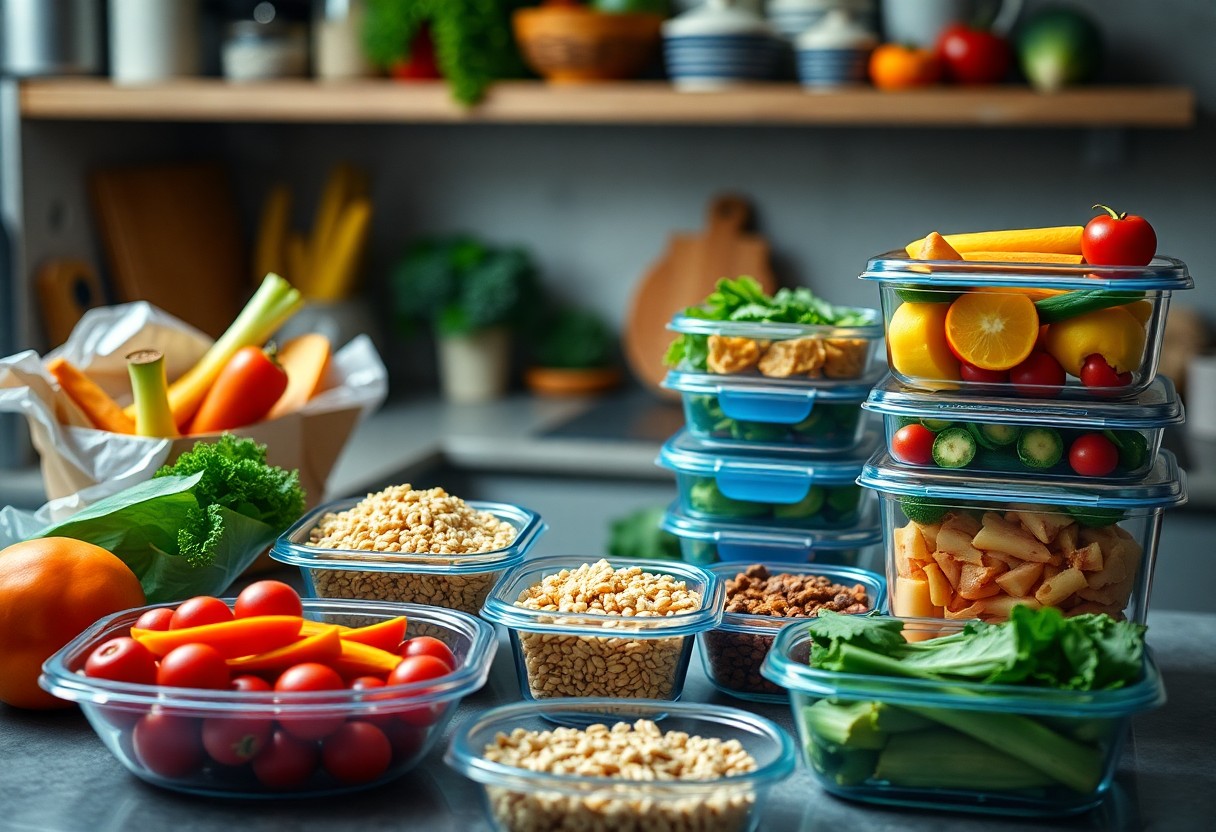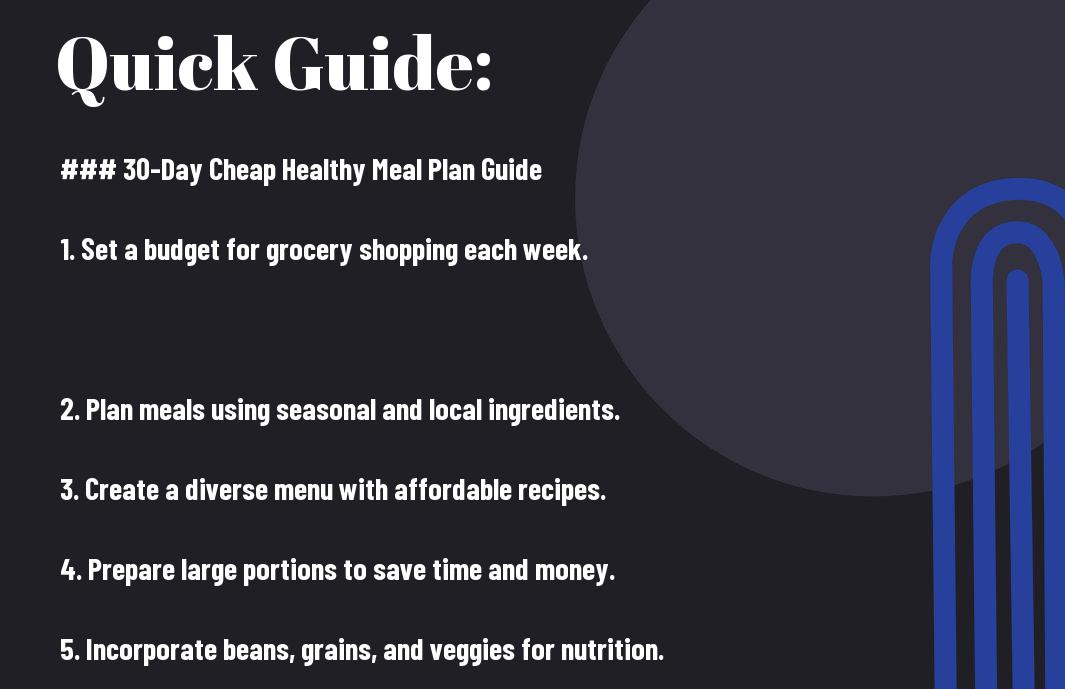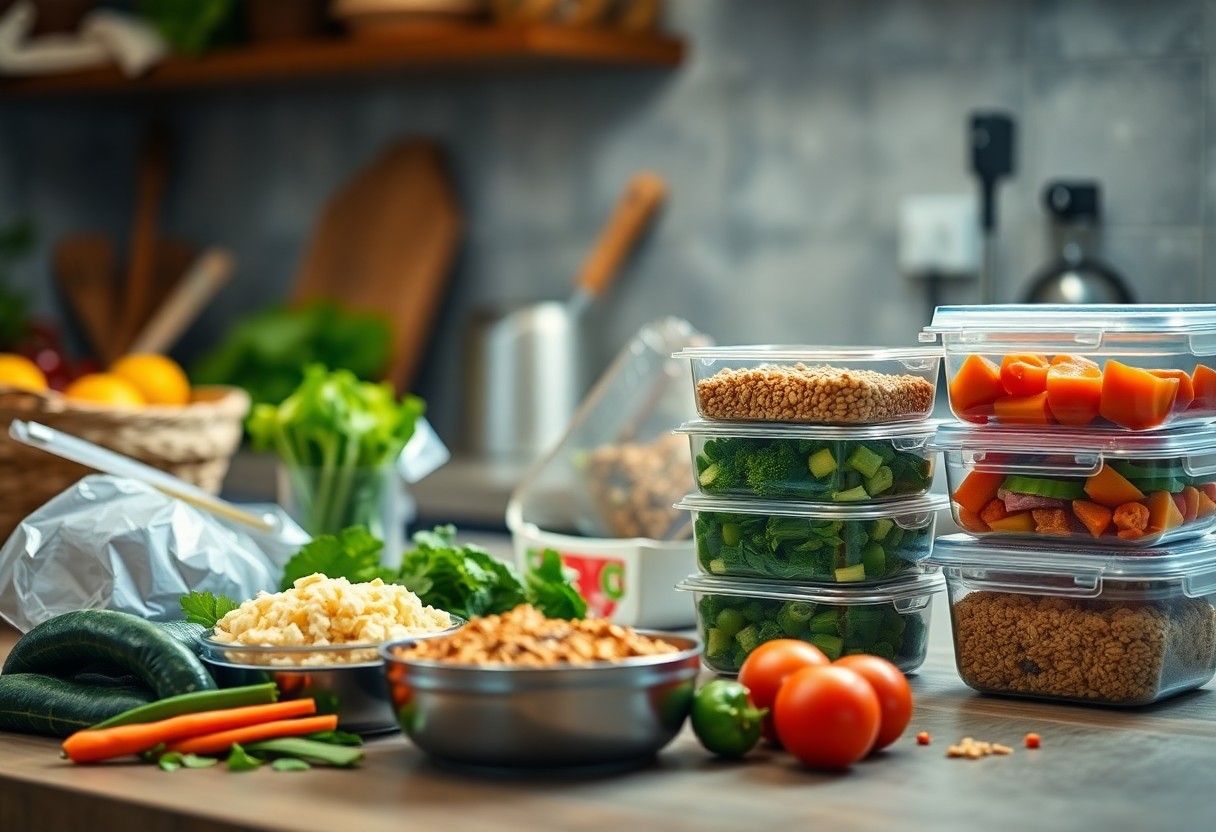There’s no need to sacrifice your health or break the bank when it comes to meal planning. In this 30-Day Cheap Healthy Meal Plan Guide, you’ll discover how to create nutritious, delicious meals that won’t strain your budget. Whether you’re a busy professional or a student, this guide provides easy recipes, grocery lists, and practical tips to help you eat well and save money. By following this plan, you’ll optimize your grocery shopping and meal preparation, giving you more time to focus on what really matters—your health and wellbeing.
Key Takeaways:
- Budget-Friendly Options: The meal plan emphasizes meals that are affordable without sacrificing nutrition.
- Variety of Ingredients: Includes a diverse range of ingredients to keep meals interesting and enjoyable.
- Health Benefits: Focuses on incorporating whole foods that support overall health and wellness.
- Meal Prep Strategies: Provides tips for efficient meal prepping to save time and reduce food waste.
- Easy-to-Follow Recipes: Features simple recipes that are quick to prepare and cater to various skill levels.
- Weekly Grocery Lists: Offers organized shopping lists to make grocery shopping seamless and efficient.
- Flexible Portions: Encourages adapting portion sizes to meet individual dietary needs and preferences.

Understanding Meal Planning
The process of meal planning involves organizing your meals for a specific period, usually a week or month, to ensure you’re eating healthy while staying within budget. This approach not only helps save time but also reduces food waste and encourages you to try new recipes. By planning ahead, you can make better choices that align with your health goals while saving money.
Types of Meal Plans
The various types of meal plans cater to different dietary preferences and schedules. Each approach offers unique benefits that can help you stay on track with your nutrition.
- Weekly meal plans for busy lifestyles
- Portion-controlled meal plans for weight management
- Family meal plans to encourage shared meals
- Vegetarian or vegan meal plans for plant-based diets
- Prep-ahead meal plans for convenience
| Weekly Meal Plans | Best for busy individuals |
| Portion-Controlled Plans | Great for weight management |
| Family Plans | Encourages sharing meals together |
| Vegetarian/Vegan Plans | Fulfills plant-based diets |
| Prep-Ahead Plans | Offers convenience and time-saving |
Perceiving the variety of meal plans can help you choose one that aligns with your culinary preferences and lifestyle.
Key Factors to Consider
Some important factors to consider while planning your meals include dietary restrictions, budget, and personal taste preferences. Focusing on these elements can lead to more successful meal preparations and a greater likelihood of sticking to your meal plan.
- Allergies or dietary restrictions
- Monthly budget for groceries
- Cooking skills and preferences
- Time availability for meal prep
- Family preferences and portion sizes
To ensure your meal plan is effective, tailor it based on your specific needs and circumstances. Evaluate what works best for you and adjust accordingly, as flexibility may enhance your experience. Additionally, consider the following after your initial plan is in place:
- Track your grocery spending
- Adjust recipes to minimize food waste
- Experiment with seasonal ingredients
- Seek inspiration from various cooking sources
- Share your meals with family to enjoy diverse flavors
By focusing on these key factors, you can create a sustainable meal plan that fits your lifestyle while ensuring your meals remain healthy and cost-effective.

Budget-Friendly Meal Options
Any budget-conscious meal plan can include a variety of delicious, nutritious recipes that won’t break the bank. For inspiration, check out this 30-Day Heart-Healthy, Anti-Inflammatory Dinner Plan, packed with affordable ideas that can help you stick to your meal budget while enjoying tasty and healthy dishes.
Affordable Protein Sources
There’s a plethora of affordable protein sources you can incorporate into your meals, such as lentils, beans, and eggs. These items are not only cost-effective but also versatile, allowing you to create a range of protein-rich dishes that fit your budget.
Cost-Effective Vegetables and Grains
For a healthy meal plan, load up on cost-effective vegetables and grains that add both nutrition and flavor without the hefty price tag. Think seasonal produce, frozen vegetables, and bulk grains like rice and quinoa.
Another great way to incorporate budget-friendly vegetables and grains into your meals is to focus on buying in season or shopping at local farmers’ markets. This strategy often yields lower prices and fresher options. Additionally, stocking up on grains such as oatmeal or whole wheat pasta allows you to create numerous satisfying meals while keeping your grocery bill in check.

Healthy Eating Tips
Unlike following restrictive diets, adopting healthy eating habits can be both enjoyable and budget-friendly. Consider these tips to enhance your nutrition:
- Incorporate more whole foods into your meals.
- Plan your meals around seasonal produce.
- Make a shopping list and stick to it.
- Opt for bulk purchases to save money.
After implementing these strategies, you can explore The Ultimate Monthly Meal Plan On A Budget for more guidance.
Meal Prep Strategies
You can simplify your cooking routine by embracing meal prep. Start by designating a day each week to prepare ingredients and meals in advance. This helps save time on busy weekdays and minimizes waste. Batch-cooking grains, proteins, and vegetables can make it easy to mix and match combinations for diverse meals throughout the week.
Balancing Nutrients on a Budget
The key to maintaining balanced nutrition while sticking to a budget is understanding how to choose affordable foods that offer the most nutrients. Focus on whole grains, legumes, and seasonal produce as these options typically deliver both health benefits and savings.
Plus, incorporating affordable sources of protein like beans, lentils, and eggs can help you fill up on crucial nutrients without breaking the bank. Make sure to include a variety of colors and types of fruits and vegetables in your diet to ensure you’re getting a range of vitamins and minerals, enhancing your overall health without overspending.
Step-by-Step Meal Planning
Keep your meal planning organized and stress-free by following a structured approach. This will not only help you save time, but also ensure you stick to your budget. Use the table below to outline your meals, shopping lists, and preparation times efficiently.
| Step | Details |
|---|---|
| 1. Determine Your Schedule | Outline your week and identify the best days for meal prep. |
| 2. Plan Your Meals | Select recipes and distribute them across the month. |
| 3. Create a Shopping List | Compile all ingredients needed for the planned meals. |
| 4. Prep Ahead | Spend time prepping ingredients to save cooking time. |
Creating Your 30-Day Plan
Planning your meals for an entire month can seem overwhelming, but breaking it down into smaller steps makes it manageable. Start by selecting a variety of recipes that cater to your dietary preferences. Aim for a balance of proteins, grains, and vegetables, and distribute these meals throughout the month to prevent monotony.
Shopping List Essentials
On your journey to meal planning, a well-organized shopping list is important for staying on budget and ensuring you have all the necessary ingredients. Write down staples you will need for each recipe, and consider bulk buying for cost-efficient items.
Your shopping list should include various categories such as proteins, grains, fresh produce, canned goods, and spices. By categorizing these items, you’ll streamline your shopping process and minimize impulse buys. Aim to focus on whole, unprocessed foods that are nutritious and can be used in multiple recipes to maximize your budget and enhance versatility. A little prep work can go a long way in saving both time and money!
Pros and Cons of Cheap Meal Planning
After evaluating cheap meal planning, it’s vital to weigh both the advantages and disadvantages it presents. The following table summarizes key points to consider:
| Pros | Cons |
|---|---|
| Saves money on groceries | May require more time for planning |
| Encourages healthier food choices | Limited ingredient variety |
| Reduces food waste | Potentially less convenient |
| Enhances cooking skills | Can become monotonous |
| Improves meal organization | Requires upfront investment of time |
| Enables bulk buying | Needs storage space |
For further inspiration, check out 10 Budget-Friendly Weekly Meal Plans to Make Right Now.
Benefits of Budget Meals
If you commit to budget meals, you’ll notice significant savings in your monthly expenses. Planning your meals ahead allows you to be strategic in purchasing, which not only helps your wallet but also encourages you to prioritize nutritious options. Over time, you may find yourself developing efficient cooking habits and meal prep skills.
Potential Drawbacks to Consider
Clearly, while cheap meal planning has its advantages, it also has potential drawbacks that you should keep in mind. Sticking to a tight budget may lead to fewer choices in the supermarket, which might limit your culinary creativity.
It’s vital to recognize that rigid meal planning can sometimes feel restrictive. You may find yourself craving variety or fresher options that aren’t always economical. Additionally, the time commitment for planning and prepping can be significant, especially if you’re not used to it. Balancing cost-effectiveness with enjoyment while cooking and eating is crucial for maintaining a sustainable meal plan.

Adjusting the Meal Plan
Your meal plan should serve your lifestyle, not the other way around. As you go through the 30 days, feel free to make adjustments based on your preferences, availability of ingredients, or schedule changes. This flexibility will help you stay on track and enjoy the meals you are preparing while ensuring that you are meeting your nutritional goals.
Substitutions and Modifications
Clearly, it’s important to accommodate your taste preferences and dietary restrictions. You can substitute ingredients that you don’t enjoy or that aren’t available, ensuring you still maintain balanced nutrition. For instance, if you’re not a fan of quinoa, try brown rice, or opt for chicken instead of tofu, while still keeping an eye on portion sizes and overall healthiness.
Flexibility for Dietary Needs
Even if you have specific dietary requirements, this meal plan can be easily adapted to suit you. Whether you are vegetarian, gluten-free, or have allergies, small changes can make a big difference in enjoying your meals while still adhering to your dietary restrictions.
To modify the meal plan for your dietary needs, explore substitutes that align with your health goals. If you are vegan, replace meat with legumes or plant-based proteins. For gluten sensitivities, swap out wheat products for gluten-free grains like rice or quinoa. The key is to be creative while ensuring you hit your nutritional targets, allowing you to enjoy variety without sacrificing health.
Conclusion
So, with the 30-Day Cheap Healthy Meal Plan Guide, you have the tools to transform your eating habits without breaking the bank. By planning your meals and focusing on budget-friendly ingredients, you can nourish your body while saving money. You’ll discover that healthy eating doesn’t have to be expensive or complicated. Use this guide to empower your grocery shopping and meal preparation, ensuring that your nutrition aligns with your financial goals. Happy cooking!
FAQ
Q: What is the ’30-Day Cheap Healthy Meal Plan Guide’?
A: The ’30-Day Cheap Healthy Meal Plan Guide’ is a comprehensive resource designed to help individuals or families eat healthily while staying within a budget. It includes a variety of meal plans, shopping lists, and recipes that prioritize nutritious ingredients without straining your finances.
Q: How can I benefit from this meal plan guide?
A: By using this meal plan guide, you can save money on groceries, reduce food waste, and improve your overall health. The guide provides balanced meals that incorporate necessary nutrients, making it easier for you to maintain a healthy diet while being cost-effective.
Q: Is the meal plan suitable for specific dietary restrictions?
A: Yes, the meal plan can accommodate various dietary restrictions. Alternatives for common allergens, such as gluten or dairy, can be provided within the guide, along with vegetarian and vegan options. You can customize the meal plan to meet your specific needs and preferences.
Q: How much time should I allocate for meal prep each week?
A: On average, you should plan to spend about 1 to 2 hours each week on meal prep. This includes grocery shopping, cooking, and storing meals. Efficient planning and batch cooking can make this process faster and easier, allowing you to maintain healthy eating habits with minimal daily effort.
Q: Are the recipes easy to follow for beginner cooks?
A: Absolutely! The recipes included in the meal plan guide are designed to be user-friendly and simple to follow. Each recipe features clear instructions, commonly available ingredients, and tips for easy preparation, making it perfect for both novice and experienced cooks.
Q: Can I use the meal plan for my family or household?
A: Yes, the meal plan can be adapted for families or larger households. The guide provides portion sizes and suggestions for scaling recipes up or down, ensuring that everyone in the family can enjoy fulfilling and nutritious meals without overspending.
Q: Where can I access the ’30-Day Cheap Healthy Meal Plan Guide’?
A: The guide can be found online, typically available for download or purchase on health-oriented websites and platforms. Check the specific site for formats available, such as e-books or print versions, to choose the option that best suits your needs.





